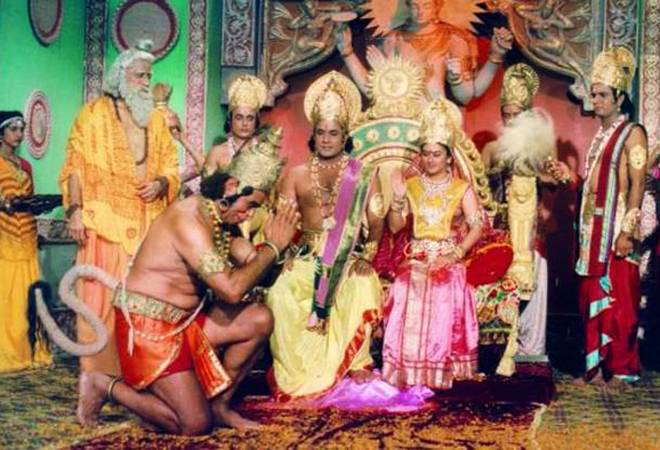The Hindu Traditionalist (II): Culture, Morality and Reform
A Brief Recap from Part I
Culture is communal habit. Plain and simple. But the important question that arises after this is where do these habits come from? What is their nature?
There are essentially three views (I will be using these three terms going forward)
“Trad-Culture” – Culture comes from Tradition which in turn comes from a particular Metaphysical Worldview. This is the Traditional view.
“Techno-Culture” – Culture is created when Humans react to the possibilities offered by Technology This is the Modern view.
“Whatever-Culture” – Culture is ‘Whatever the Hell’ we want it to be. This is the Post-Modern view.
“Their words, their data, their facts, their lofty ideals all collapse under the weight of the crassness of their outcomes”
PART II.
A Meditation on Morality
1. Counterculture
The ideal that both the saint and the sinner are equal before God set in motion the Christian revolution two thousand years ago. It took almost 1,600 years before the full impact of this “radical individualism” began to be felt within Christian society. It led eventually to the Protestant Reformation, which, in a few short centuries led Christian Europe to the doors of “secularism” and “atheism”. From then on, it was a short step to the adoption of “Liberty” (the idea that life is a playground for self-gratification) as one of the founding ideals of modern Western civilization. Since that moment, some 250 years ago, Western civilization has been falling apart, slowly but surely, accelerating every day. Against all available material evidence, I will stick my neck out and say that the West has been falling apart, because the culture engendered by the embrace of “liberty” was not really a culture at all, but a counterculture.
The Beatles, Jimi Hendrix, Led Zep, Woodstock etc., are famously/popularly included in this counterculture movement but they were just the perfect manifestations of Western liberal social ideals. What was “counter” about them? Nothing at all. So, what goes by the name of Western culture is then a counterculture in essence (the Cancel-Culture of today is another symptom of the very same malaise). Culture, traditionally, has always been that which has tacitly enforced behavioral rules in society. When people followed these rules, stability ensued, and in the Hindu understanding, stability is the founding principle from which spring order, peace, prosperity, and well-being. With the anointing of “liberty” as the king of ideals, what the West embraced was not a new culture but in fact a stance that was “anti-culture,” which actively pursued the breaking of rules in the service of self-gratification. This type of societal carte blanche given to the breaking of cultural rules inevitably leads to the falling apart of that very same society. “Western Liberal Culture” is entropic in its essence, if not outright cannibalistic.
We must be clear that all Liberty-style freedoms are subsidized, either by other people’s efforts or by Bhu Devi’s abundance. There are cultures that recognized this and attempted to payback their debt (most famously encoded as the Pancha Rina in the Hindu context) and there are cultures that want freedoms with no thought of repayment. The latter can only thrive in the short term by borrowing from the future or from other people and places. In the case of the West, the initial subsidy came from slavery and colonial depredations. The twin engines of this parasitic system of subsidy — extreme inequality and extreme exploitation of Bhu Devi, have carried on to this day in less overt forms.
The immoral wealth that this exploitation produced, aided by the industrial methods and machines perfected in the West, created an economic surplus of gargantuan proportions. It was this surplus that helped feed, and indeed continues to feed, the delusion that “liberty” is achievable for all individuals, for all time to come! Today, we are well past a civilizational tipping point. Those of us who have an ecological conscience can see with clarity that with the slow disappearance of natural resources that keep the western industrial societies afloat, the surplus that feeds the delusion of ‘liberty for all’ too will dry up. And with that, “liberty” itself will vanish. In its place, a culture of stability must re-emerge in the West. In other words, the West will be forced, soon, to revert to a real, rules-based culture, one that harbors sustainability of natural resources and human relations at its core. Because there is no other way. I’m sorry, but humans are not going to live on Mars.
Question: So, what happens when a “liberty” fueled counterculture is set in motion in a materialist society?
Answer: We get runaway machine worship.
Human beings infected by this potent mix of “Liberty, Materialism and Techno-Culture”, start to recognize machines as the entities that bring them “liberty” (which is a fact at the superficial level). And since anything that brings this liberty is sacred in their “liberal universe”, the Machine becomes sacred. When machines become sacred, human beings start to see themselves as beholden to them. If you observe the statements of an intelligent man like Elon Musk, you will see what is coming our way. Musk believes, in all sincerity, and with guarded enthusiasm, that humans were put on Earth to facilitate the emergence of “Machine Intelligence”. He sees us as the evolutionary link between apes and self-aware machines. When self-aware machines reach their full potential and begin to use us for their own benefit, eventually erasing us from the planet (while, perhaps, maintaining a store of our DNA for future reference) Elon Musk believes that human purpose would be fulfilled! This is the end-game (watch 16.30 secs onwards).
This is not a Hindu vision.
2. Future Perfect – The Great Inversion
The materialist Western idea that all culture is determined by technology has led to a very specific vision of the human journey. This vision is one that prioritizes material sophistication as the primary benchmark of worth. This has led to the common trope that we have “advanced” from being hunter-gatherers to agriculturalists to modern industrial people and our cultures during each of those phases were merely the result of parsing the physical world through our tools.
So, if today, America has a “hook-up culture” a Western commentator would be tempted to say that this culture has its roots in the invention of birth control, the Internet, and social media apps. This is of course factual and a sometimes-useful way to look at the world, but it hides a deeper truth and that is the answer to the question: “Why?” Why have birth control and the Internet resulted in this “hook-up culture”? Was it inevitable as many believe? Or did these technologies evolve this way because the white man allowed them to evolve that way? In other words, did these technologies flow through the deep beliefs of the white man and emerge in this shape or did the white man flow through the deep internal logic of these technologies and emerge this way?
We have seen (in Part 1 of this essay series) that technology impacts culture in dramatic ways. Westerners who adhere strongly to Techno-Culture, are happy to go wherever their tools lead them because it is their tools that have brought them the power that they have wielded over the past three centuries. They will go live on Mars, they will implant chips in their brains, they will freeze their bodies, they will do gain-of-function research on deadly viruses, and they will literally do anything if it smells of technology. But… if we are a conscious people, we can see that this way of being is madness and will hopefully reach its unsustainable end very soon so we can all get back to normal life.
Normal life — where culture is a stabilizing force in society that grants communities and individuals familiarity, predictability, shelter, identity, pride, love… all that stuff that is in short supply today. In such a society, change, when it happens, is consciously curated by citizens. In such a society, common people are not forced into obsolescence every five years, parents and children have a commonality of values that they share and make them recognizable to each other, common people who master a trade can hope to contribute to society for the entire length of their lifetimes, grandparents can imagine dying at home, surrounded by their grand kids, and common people can hope to eat food that is not poison. These are not unreasonable asks. These are in fact the qualities of life that our parents and grandparents enjoyed until a mere three decades ago. Today, a person demanding these ordinary things is seen as either a communist or a fool. By submitting to Techno-Culture and its ideological child, Whatever-Culture, we have entered a world where the rate of change in society is so great, that today, a great inversion is in progress. Where yesterday, parents used to represent the wisdom of the ages and the experiences of a lifetime, we now have children representing the techno-knowledge of the present and the cultural-cool of the future. Within this new paradigm, it is no longer the tribal knowledge from the past that helps humans survive, but it is the ability to withstand the stress of predicting and adjusting to the constantly mutating machine-made future that helps humans survive. Parents are having to submit before the ideological and lifestyle demands of their children. Parents are having to evolve to appear cool to their children. Parents are having to abandon the inherited wisdom of the past and instead rely on their children to initiate them into the techno-tools and the culture-cool that serve as gateways to the future. The values of such a world will inevitably be teenage in their essence. Over the past three decades in Bharat, there has been a huge move towards glorification of these values – impatience, change-centric economic structures, fashion culture, techno fascination, sex obsession, emotionalism, short term goals, distraction, and superficiality — in other words the MTV-fication of life itself. We see this all around us today. The fundamental idea of stability as a foundation for human well-being itself has vanished. If Dharma is defined as “that which lends stability” then we are free to draw our conclusions on what this new type of world should be labelled. The middle-aged and the old have no place in this world. This inversion leads only one way when we follow it to its logical conclusion – the elimination of everything that is “backward and/or inefficient” — the dissolution of marriage, family, tribe, and ultimately hetero-sexual reproduction itself. A Matrix-like future is predicted.
This post-Christian, Western surrender to Techno-Culture is the single reason why every Hollywood science fiction movie is set in an apocalyptic machine-verse where the hero, always a person who is subject to human flaws, fights the machine-ness of his surroundings and re-establishes the sanctity of the human condition. This theme pervades every movie from Star Wars to The Matrix to Minority Report. At a deep psychological level, each of these movies is exactly the same movie. The white man is playing out a terrible dilemma in these movies: he knows he is sick, he wants to turn to God, to cure himself, to believe that there is some shred of sanctity left in his humanity but finds that he cannot. He has surrendered to the machine instead. There is not a single science fiction movie that shows a future where man and beast live happily under the Gods-given sky. Instead, what we have is the repeated replay of the fall from Eden into deeper and deeper Hells. Founding myths are powerful indeed.
Let me spell it out clearly then: “This stuff is no good!”. This stuff is not Hindu. It has NOTHING whatsoever to do with the Hindu mythic mind. It is imperative that our technologies submit to the logic of our metaphysics and not the other way around. It is our traditions and not our technologies that represent us
This brings us back to Trad-Culture and the idea that culture is a collection of traditions along multiple verticals – food, art, worship, life processes, work, war, etc. These traditions flow from a worldview, a metaphysics of how the world came to be, and what its true nature is. Core Hindu culture flows from a very specific set of metaphysical ideas — Brahman, multi-birth Karma, Purushartha, and Moksha.
Similarly, Techno-Culture and Whatever-Culture too flow from a higher-order metaphysics though we have been schooled to think of them as neutral and universal. They are not neutral, and they do not have to be universal. At their heart lie the beliefs that there is nothing sacred about being human, that the Gods don’t exist, that there is no good or bad, that power and pleasure can be pursued for their own sake, that life, all-encompassing “Life” itself, is ultimately meaningless. These are not Hindu values.
If you are a Hindu by birth who is unconsciously veering towards these values of Techno-Culture or Whatever-Culture you are taking very significant steps away from the cultural heritage of your ancestors. Core rewiring is happening in your brain, the aesthetics of your morality itself is being tinkered with by mass media and the education system. A new metaphysical operating system is being booted into your hardware. You are the converted.
3. A Peek into our Hard Drives – The Idealist West and Visionary Bharat
So, let us start our purva-paksha by defining a few terms:
- Morality refers to a system of values.
- Ethics refer to a moral code – It includes an analysis of morality and an attempted rational justification for choosing one morality over another.
- Law refers to the institutionalization of ethics.
We can see now that all morality therefore comes from an a priori understanding of the world – this understanding goes by the term, “Values”. Values are the direct offspring of metaphysics and are usually hidden from our minds. People living within a value system are usually unaware of their values, as they live in the second-order framework of morals. In normal conversation people make moral judgements without specifying their value system.
The communal habits (culture) of a people are held by that society to be moral.
For example, when Westerners say something is bad or good in Hinduism, they are judging us as per their morality which in turn is based on the values of their metaphysics. There is nothing inherently true about their judgements of us.
I am told that Christian scholars accuse us of being inferior because we do not have a code of ethics. I don’t know if this is a legitimate critique or not, and perhaps we haven’t written down a code of ethics like Thomas Aquinas and Immanuel Kant did. But does that really matter? Does that make us immoral? Does it make us incapable of framing laws? Of writing such a thing as a Constitution?
From a simple study of Hindu community behavior, it is obvious that we are a moral people. We also know that we had law established across this land via the dharma-shastras. So, what was different in the way our ethics were encoded in society if not in the form of rationally argued books? I think this is the key question. The accusation that we don’t have an understanding of ethics is patently false and has been made by people who are inordinately tied to the idea of a “book” as being the sole dispenser of legitimacy. It only remains to ask how Hindu Ethics were articulated if not in books.
I propose that our ethics were encoded in “Ritual”. And their primary purpose was not the upholding of ideals (as it is in the West) but the attempt to embody a set of divine archetypal visions for the establishment of human welfare and individual emancipation.
The West is idealistic — Individualism, Liberty, Equality, and Universalism — these are all ideals. These ideals do not exist in reality, but they have a certain mathematical symmetry about them which is what gives them their beauty and their attractiveness. Seemingly mesmerized by their beauty, Western society pursues these ideals like a moth to a flame, far beyond the point where they result in human welfare. Let’s call this type of morality Idealist-Morality.
Hindu society, ironically, is far more pragmatic. Our societal structures are a vast set of interlocking, moving parts that are constantly self-reflecting on the complex nature of Truth, Satya. Life is seen as a series of compromises that is slowly working its way towards a divine perfection. We know, deep down, that anything we do can possibly be both right and wrong at the same time; so, our concern in organizing human society has been “how do we make things a little bit right for everyone concerned?” We’ve focused on compassion, on sharing, on balance, on order, on peace, on sustainability, on the paths that lead to a resentment-free existence. To this end, we accept as our inner compasses the lives of our devatas, pauranic heroes, and our avataras as archetypes — Ram Rajya, Krishna’s Vrindavan, Shree and Vishnu in Vaikunta, Parvati and Shiva in Kailasa, Samudra Manthan of the Ksheera Sagara, the battle between Ma Durga and Mahishasura, Muruga standing on Palanimalai, Ganesha as his mother’s gatekeeper, Hanuman leaping across the ocean, Draupadi in Duryodhana’s court, Bheeshma on a bed of arrows, Arjuna at Kurukshetra, Yudhisthira at the gates of Swarga, Gautama under the Bodhi Tree… this imagery, these visions are the repositories of our morality. In our insignificant personal lives, we touch the divine, every day, when we see our lives reflect these visions. From birth, we are taught to orient our lives to their aesthetic. Let’s call this type of morality Visionary-Morality. Hindu visionary-morality is outcome-centric and has as its goals communal well-being and individual emancipation.
Idealist-Morality is sharp, hard, angular, and efficient. It aims to create a perfect system by the application of ideals (a type of heaven). It is not interested in the true nature of reality. It wants, instead, to shape reality itself as a reflection of its ideals. This kind of system serves as a filter. People are drawn through this filter of ideals. On one side of the filter great and driven (and stressed) achievers are generated. On the other side of the filter collects the detritus of society growing day by day in ugliness. Being an un-natural system imposed on humans, this morality needs draconian regulation and punishment to make it work.
Visionary-Morality is blunt, soft, and rounded. It is relatively inefficient but feels like home. It aims to create a pragmatic human system based on an understanding of “Reality”. The system nudges people towards the re-enactment of archetypal visions in its bid to create order. This re-enactment of archetypal visions lends society a great beauty, sustainability, vitality, and regenerative ability. When cut off from our visions, as many of us are today, we descend into and succumb to what is commonly called “corruption”. Getting Hindu society out of corruption is hard because we have no ideals to take the place of our abandoned visions. The only way forward is to reconnect our society with our visions and that requires the long-term exposure to these archetypal visions at a young age. In other words – schooling in the Hindu Itihaasa and Purana. This is not teaching mythology, but this is literally reconstructing our morality. This is what will lead to a “corruption”-free society, and the building of a foundation of a new and desi set of laws and systems of governance.
We are not an arrow released from a bow; we are the ripples on the surface of water. Our growth is not linear, it is concentric. Our destination is not an imaginary target far away but the divine center that caused us to ripple forth. That center is both our origin and our destination. No matter how large our circle grows, we remain defined by and focused on our center. That is the very nature of a circle. There is no circle without a center. There is also no center without a circle, and it is for this reason that our ancients understood that although it is through the Gods that our traditions arose, it is also through our traditions that our Gods live on.
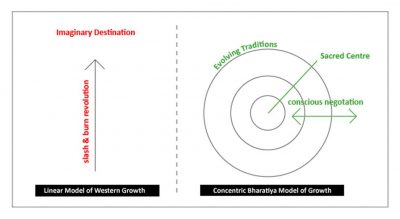
When we walk the circular patterns of our traditions, we literally call the center into being. This is the great secret of all natural religions and traditional cultures. We call our Gods to life in our midst when we walk in the footsteps of our ancestors. This amazing metaphor for life is also physically enacted in many of our festivals. For example, in rural Tamil Nadu, youth from the village take a vow of abstinence leading up to the annual Koozhu Oothara Vizha. On festival day, as a culmination of their sacrifices, they carry the heavy garagams on their shoulders and assume the form of walking Gods. They walk from house to house accompanied by musicians, drummers, and the local keeper of the village shrines. As the youth slowly traverse the length of the village, members of each household emerge from their homes with offerings of fruit and seek blessings for their children. They worship these now transformed youth who till yesterday were merely their neighbors. The youth, then carrying their literal burden of the garagam and the figurative burden of the entire village’s prayers, make the final trek to the Graama Devata and offer their efforts to the deity, prostrating before Her.
We live in this metaphoric balance, and it is this that has lent us our immense longevity and creativity. When we abandon our older traditions without creating anything of equal worth and beauty for the present (a larger concentric circle), we break our circularity, we erase our center… and we abandon our Gods.
4. Judgement
So, how do we compare Hindu society and Western society?
A comparison of Western Ideals with Hindu Archetypal Visions would be like the cliched comparing of apples and oranges. Similarly, comparing Western book-based ethics with Hindu ritual-encoded ethics would be equally meaningless. Just can’t be done. These are two totally different cognitive categories.
So, what is it that Westerners did when they encountered Bharat? How is it that they have been passing judgement on us for the last three hundred years?
All these centuries, Westerners have looked at our societal outcomes and judged them by their ideals. In doing so, they found (obviously) that we were deficient.
Squeeze Varna through the Equality filter –> FAIL
Squeeze Jaati through the Individualism filter –> FAIL
Squeeze Bharatiya naari through the Liberty filter –> FAIL
Squeeze Traditional Communities through the Universalism filter –> FAIL
They have spent the last three hundred years judging our societal outcomes based on their idealist moral standards and ridiculing us. It is time we returned the gaze. Let us judge, today, their societal outcomes against our visionary moral standards and see where they stand. We will see that by our visionary moral standards, Western society is sick indeed. We will also see that we do not have to accept judgment of our outcomes by their ideals. We will see also that Western morality is not “natural” justice, and that it is just as arbitrary as any other value system.
And I’m going to do this with images rather than words so that we can break through the supremacy of the written word. These images will not just describe but actually show us why our values are better because our outcomes are better. There will be no room left for doubt.
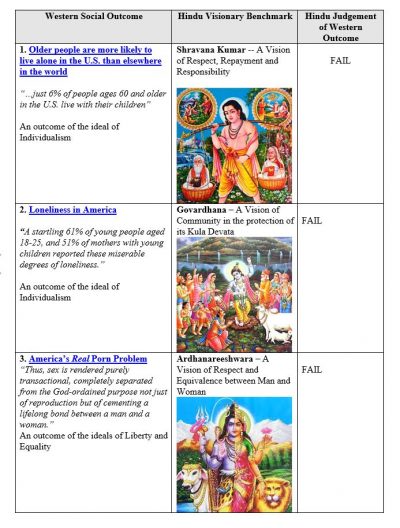
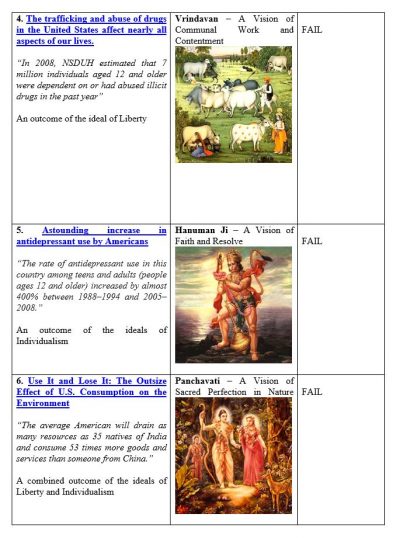
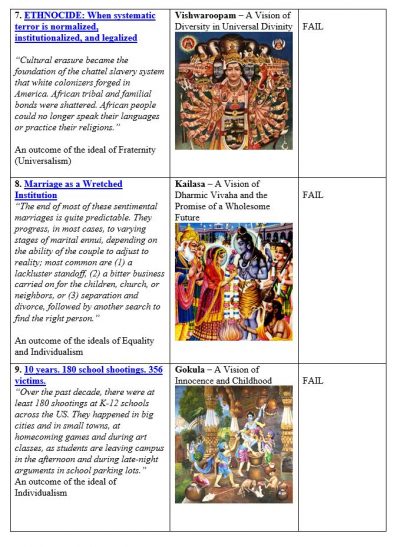
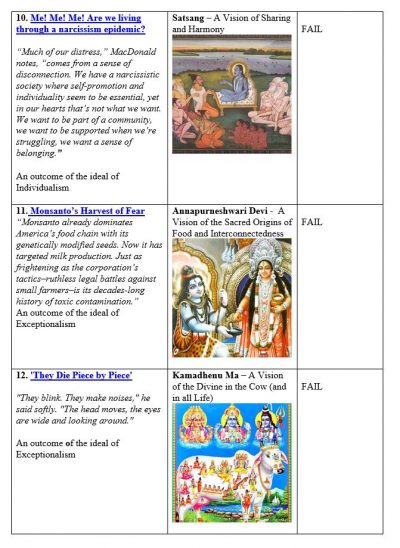
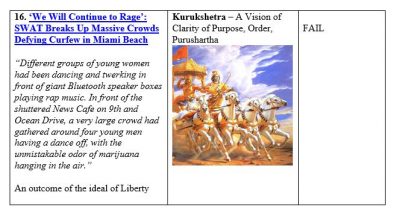
Hindus need to keep in mind when talking to Christians/Liberals about ethics and morality that we follow a Visionary-Morality that is expressed in a Ritual-Language that they simply cannot understand unless they become practitioners. We must drag every such discussion away from their Ideals to the level of outcomes and always judge their outcomes by our values… our values that are manifest in our archetypal visions: Does this look like Ram Rajya? Would Ma Parvati act this way? What punishment would Shri Krishna prescribe? What would Hanuman do?
5. Shredding Society with the Cutting Edge of Liberty
Liberal Individualists demand the freedom to indulge in the gratification of their senses and emotions. No matter the long term, terrible outcomes for society, they deem it immoral if this “liberty” is constrained. Note, it is not their depraved acts that are immoral but the constraining of the freedom to perform those acts that are considered immoral! This is the great and deep unseen change that “Liberalism” has brought into our moral landscape. The individualist believes that it is in this exploration of one’s deviance that one “discovers” oneself. This is an amazing idea. Believe me, even though this may appear “normal” to some of us today, this idea is so far-fetched and crazy that the West has spent three hundred years pillaging the earth to rationalize post hoc, to themselves, and to convert every other human into their fold — so the idea of deviance would be normalized. This remarkable exercise in cultural-entropy and normative inversion continues today via the movies, music, social media, and higher education. Our children are not immune.
There was a time when Christian society had values. These values were not Visionary as in the Hindu case but were in the form of commandments. These values lent Christian society an internal moral logic (no matter how immoral they seemed to indigenous peoples all over the world). But with the Protestant and Liberal turn that it has taken, all Christian values have been discarded in favor of Secular Ideals. This Idealist-Morality, as we have seen, engenders a counterculture that results in the falling apart of society (cultural entropy). Curiously, people who subscribe to an Idealist-Morality are prepared to follow these ideals to hell if need be and abandon all values that come in their way. For example, the ideal of liberty is placed on such a pedestal that today there are fathers who support their daughters’ OnlyFans page. Similarly, the ideal of individualism has been raised up to such an extent that a man would rather let his parents live and die alone than sacrifice what it takes to have them die among family in his house. Equality has been raised up to such an extent that parents are willing to allow their young children being exposed to kinky sex at school in order to virtue signal that they are non-discriminatory towards the LGBTQ. Universalism has been raised up to such an exalted height that Americans actually believe that they will bring “freedom” to Afghanistan by waging war upon it.
Consent and a quantitative definition of adulthood (age 18) are both subroutines that run within the larger “liberty” routine. There is nothing automatically sacrosanct about them. Unlike liberals, Hindus do not consider consent and liberty to be Gods whose very spelling is sacred. These ideals will always be held up to our visionary moral standards. We will ask the questions: “Does this consensual or liberal act fall within the broad range of acts performed by our devatas, pauranic heroes and avataras?” and “Is this act in any way opposed to acts that would normally fall under our Visionary-Morality?” Acts that pass this test are ok but acts that fail this test are not ok. Hindu society has every right to brand them as adharma.
The latest rage in “liberal” circles — BDSM — is a case in point. From the point of view of the proponents of BDSM, it is the only moral relationship between man and woman because it has consent as its centerpiece. The partners consent to be physically violated thereby making an exhibition of their reverence for consent. By thus virtue signaling and putting skin in the game quite literally, they declare themselves as moral people. Normal, traditionally married people on the other hand, are seen as immoral because they fail the individualism test, the liberty test, and the equality test.
If Bharatiya culture is to survive, Indian law must respond to this challenge thrown by “ideal moralists” by simply ignoring their Ideals and choosing instead to follow an outcome-based legal framework. And of course, the best outcomes are those that reflect our archetypal visions. We know this in our hearts. Which laws and societal regulations will help us establish Ram Rajya and Vrindavan again in Bharat is the question that legal luminaries should be asking. If the law does not follow culture willingly then culture will be forced to follow law unwillingly, with all the associated societal stress and violence. It’s a simple choice really: Western Ideals that bring pain and deracination or Hindu Visions that bring joy and identity.
It helps to notice how our moralities are epistemologically structured. Equality, Liberty, Fraternity are all ideals because they do not exist in reality. They are descriptors of an unreal space that Western people believe they need to get to, a lot like Heaven. Dharma and Karma on the other hand are seen by Hindus as Laws of Nature. The Gods themselves are subject to these laws and our societal structures have evolved with this understanding at their core. We do not buy into the metaphor that we are all aboard a spaceship going to la-la land because elsewhere is better than here. In perfect opposition to that escapist point of view, we Hindus live in the here and now, reveling in the full warm glow of the divine Dharmic law. We do not rebel against reality, we do the best we can within its constraints, all the while holding the archetypal visions of our devatas, pauranic heroes and avataras as our compass.
—————-
References
https://www.vox.com/2015/7/13/8913297/mass-incarceration-maps-charts
Older people are more likely to live alone in the U.S. than elsewhere in the world
https://static1.squarespace.com/static/5b7c56e255b02c683659fe43/t/6021776bdd04957c4557c212/1612805995893/Loneliness+in+America+2021_02_08_FINAL.pdf
https://www.nationalreview.com/2016/04/pornography-destroys-american-morals-culture/
https://www.justice.gov/archive/ndic/pubs38/38661/drugImpact.htm
https://www.health.harvard.edu/blog/astounding-increase-in-antidepressant-use-by-americans-201110203624
https://www.scientificamerican.com/article/american-consumption-habits/
https://www.thedailybeast.com/i-cant-breathe-is-the-new-american-anthem-heres-how-we-change-that
https://www.theatlantic.com/magazine/archive/1966/11/marriage-as-a-wretched-institution/306668/
https://edition.cnn.com/interactive/2019/07/us/ten-years-of-school-shootings-trnd/
https://www.theguardian.com/lifeandstyle/2016/mar/02/narcissism-epidemic-self-obsession-attention-seeking-oversharing
https://www.vanityfair.com/news/2008/05/monsanto200805
https://www.washingtonpost.com/archive/politics/2001/04/10/they-die-piece-by-piece/f172dd3c-0383-49f8-b6d8-347e04b68da1/
https://www.huffpost.com/entry/irreverence-is-the-new-reverent_b_5608381
https://www.cnbc.com/2021/04/23/elon-musk-aiming-for-mars-so-humanity-is-not-a-single-planet-species.html
https://www.independent.co.uk/news/world/americas/american-excess-a-wall-street-trader-tells-all-1674614.html
https://www.thedailybeast.com/miami-beach-freaks-out-over-massive-spring-break-crowds-declares-state-of-emergency
https://twitter.com/tumtonks/status/1339033973192798212
https://www.ioaging.org/aging-in-america
https://twitter.com/lporiginalg/status/1257479575010865152
https://2001-2009.state.gov/s/ct/rls/rm/9505.htm
Images
(The copyrights for these images, where they exist, rest entirely with the creator/owner of these images. This essay uses these images for demonstration purposes only.)
Shravan Kumar – https://in.pinterest.com/meenagupta034/shravan-kumar/
Ardhanareeshwara – https://hemaspiritualpoetry.wordpress.com/2013/04/12/cosmic-fusion-the-ardhanarishvara
Vrindavan – https://theharekrishnamovement.org/tag/vrindavan/
Hanuman Ji – https://www.rudraksha-ratna.com/articles/lord-hanuman
Panchavati – https://www.indictoday.com/long-reads/sita-feminine-ramayana/
Vishwaroopam – http://irinaspage.com/2020/06/26/chapter11/
Kailasa – https://novocom.top/view/9b3162-shivan-parvathi-marriage-images/
Gokul – https://pixels.com/art/dharma (Artist- Vrindavan Das)
Satsang – https://alchetron.com/Parikshit
Annapurneshwari Ma – https://in.pinterest.com/msjewels008/shiva/
Kamadhenu Ma – https://in.pinterest.com/pin/1151162354722164207/
Saraswati Ma – https://in.pinterest.com/akbhatia58/saraswati-mata/
Varaha Avatara – https://iskcondesiretree.com/profiles/blogs/reflections-on-varaha-dwadashi-by-giriraj-swami (Artist – B.G.Swami)
Acharya Adi Shankara – https://en.wikipedia.org/wiki/Bhaja_Govindam (Artist – Raja Ravi Varma)
Kurukshetra – https://in.pinterest.com/vishuvishalkantariya/krishna-statue/

